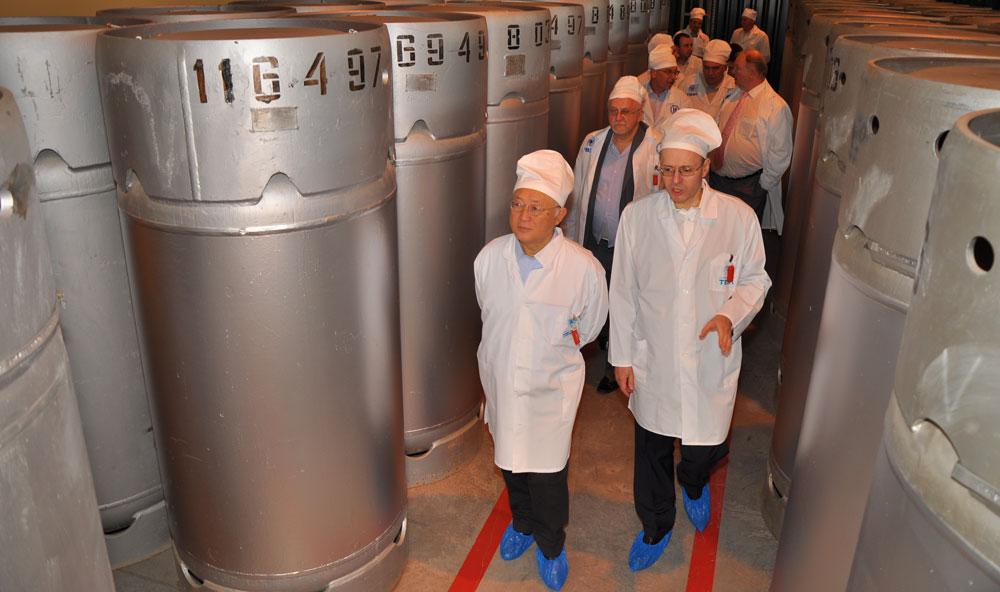
IAEA experts visited AECP and IUEC
back to contentsRussia’s initiative on international guarantees of nuclear fuel supply and services has evolved into a decision approved at the Saint Petersburg International Economic Forum to establish a LEU bank in Kazakhstan. Russia will ensure LEU transit through its territory to and from the bank if need arises. The transit agreement was also signed at the Saint Petersburg International Economic Forum by IAEA Director General Yukiya Amano and Rosatom CEO Sergei Kirienko. The first 120-ton LEU reserve at the International Uranium Enrichment Centre in Angarsk is maintained at Rosatom’s expense. The IUEC is placed under IAEA safeguards.
A model for the future
During his visit, Yukiya Amano inspected uranium separation facilities at the Angarsk Electrolysis Chemical Plant and the LEU bank maintained in the IUEC. He appreciated technologies and safety measures adopted there. According to Amano, “the LEU bank in Angarsk is a very good reference for other regional LEU banks to be created by IAEA in the future.” The IUEC-based LEU bank “is very efficient and will serve as a model for similar projects in the future,” he added. The bank is designed to “ensure sustainable operation of nuclear power plants.”
“The IAEA believes that the use of nuclear power will grow on the back of on-going climate changes, on the one hand, and economic considerations, on the other. Reliability and continuity of nuclear fuel sources is a major challenge,” said Yukiya Amano. In his opinion, nuclear fuel reserves are important to guarantee fuel supplies to countries in need, including those deprived of access to uranium for political reasons.
Nuclear power information centers are unique communication venues for children and their parents, students, and teachers. Focusing on nuclear technology education and promotion of science and innovations, information centers currently operate in 22 cities in Russia and abroad.
Replying to the question about international centers for spent nuclear fuel (SNF) management, IAEA Director General said, “The idea of joint SNF management projects has long taken shape and is considered by the nuclear community. I am sure it should be discussed in the future.”
Yukiya Amano praised Russia’s non-proliferation effort. “Russia is a leader in nuclear power and technologies. It has solid expertise and assists the global community and the IAEA in nuclear non-proliferation. It is true that cooperation in this field is beneficial to all parties involved,” Mr. Amano said.
Talking education
Meanwhile, Krasnoyarsk hosted the IAEA’s meeting on radioactive waste management. Attended by the delegates from CIS and Baltic countries, Turkey, Portugal, Germany, Austria and other nations, the meeting combined presentations and a technical tour to the Nuclear Power Information Center.
IAEA delegates were presented a report on Rosatom’s Mining and Chemical Plant in Zheleznogorsk. CEO Pyotr Gavrilov spoke about the plant and prospects of its development. The report focused on the closed nuclear fuel cycle as a means of environment protection. “For the first time in the world, all the production units have been brought together on a single site to maximize their efficiency. This integrated facility capable of supplying fuel to the entire Russian nuclear industry will turn nuclear power into a safe and renewable energy technology,” said Pyotr Gavrilov.
After the presentations, guests were taken to a technical tour round the Nuclear Power Information Center. The IAEA delegates were told about its activities and demonstrated a nuclear energy interactive program. They pointed out a great deal of work that had been done in the field of nuclear education and science promotion.
The event was organized by the IAEA and the Siberian Federal University. Lectures by leading experts in peaceful atom were open for all comers.




